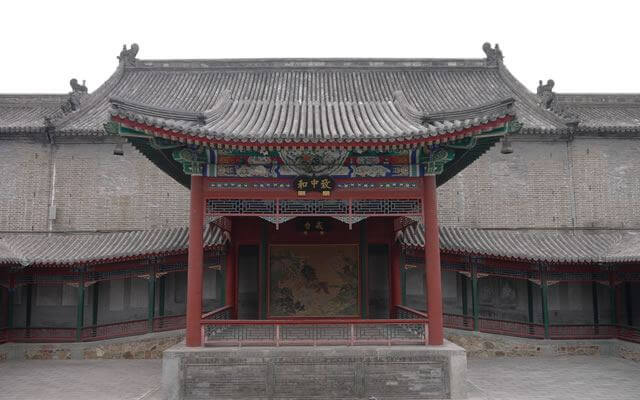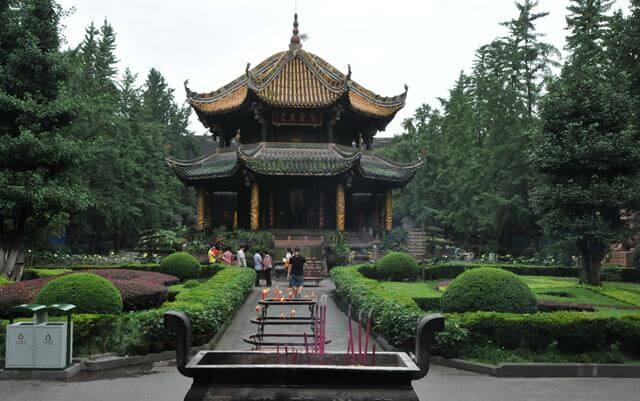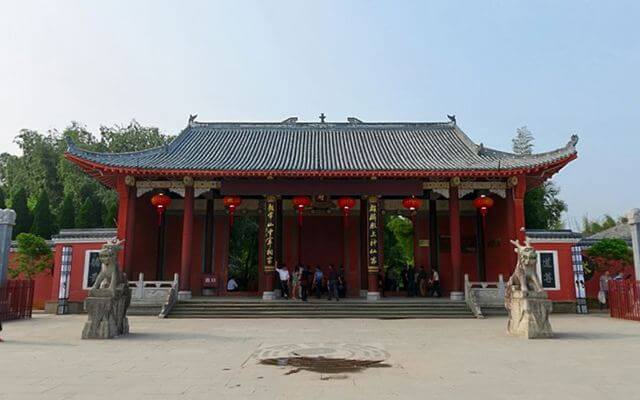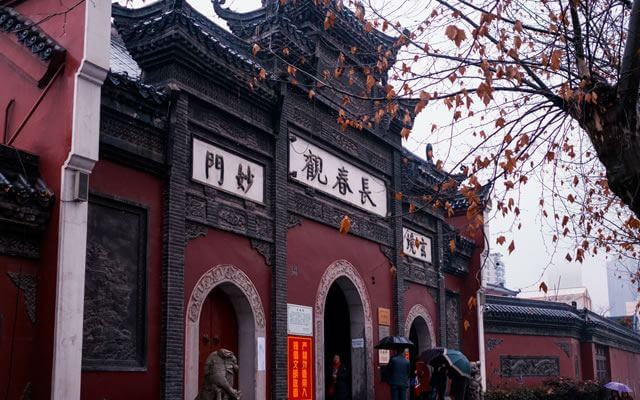Taoist Temple, as a place where Taoists worship and practice, also reflects the exquisite Chinese architectural art at that time. So where are the Chinese Taoist temples distributed? What are the top ten Taoist views? This article has compiled the top 10 famous Taoist temples in China.
1. Beijing Baiyun Temple

Baiyunguan is located in Baiyunguan Street outside Xibianmen, Xicheng District, Beijing. Founded in the Tang Dynasty, it is the holy place for Emperor Xuanzong of the Tang Dynasty to worship Laozi, named Tianchangguan. In the reign of King King Shizong, it was built and expanded, renamed Shifang Datianchangguan, and Jinmo was rebuilt as Taiji Palace. The Baiyun Temple contains a large number of precious cultural relics, the most famous are the “Three Treasures”: the Ming edition of “Orthodox Taoist Collection”, the stone statue of Laozi in the Tang Dynasty, the stone carving of “Songxue Daodejing” and the “Yin Fujing” by Yuanda calligrapher Zhao Mengfu . Baiyun Temple was first built in the twenty-sixth year of Kaiyuan of Tang Dynasty (739), originally named Tianchang Temple, Jin Mingchang three years (1192), rebuilt this view, renamed Tai Chi Palace, Jin Taihe three years (1203), Tai Chi Palace was destroyed by fire.
Address: No. 9 Baiyunguan Street, Xicheng District, Beijing
2. Qingyang Palace (Chengdu, Sichuan Province)

Qingyang Palace is located in the second section of the west section of the First Ring Road in Chengdu, Sichuan. It is one of the national key Taoist temples, provincial key cultural relics protection units, and one of the famous Taoist temples. It is known as “the first Taoist temple in western Sichuan” and “the first jungle in the southwest.” Qingyang Palace was built in the Zhou Dynasty and destroyed by military disasters in the Ming Dynasty. Most of the existing buildings were rebuilt from the 6th to 10th year of Kangxi (1667-1671), covering an area of about 120,000 square meters. The main buildings of Qingyang Palace include Shanmen, Sanqing Hall, Tangwang Palace, etc. The Bagua Pavilion is the most complete and luxurious building among them, and enshrines the statue of Lao Tzu riding a green bull. The Taoist Collection in the palace is a relatively complete version preserved in the world, and it is a precious material for studying Taoism.
Address: No. 9, West Second Section, First Ring Road, Qingyang District, Chengdu City, Sichuan Province
3. Dragon Tiger Mountain Si Han Tianshi Mansion

Tianshi Mansion is located in Shangqing Town, Yingtan, near Qingxi, where the Zhang family lived for generations. It was originally built at the foot of Longhu Mountain. To the north is Xihua Mountain, the gate is close to the Luxi River, facing Pipa Mountain, and surrounded by mountains and water, it is majestic. Covering an area of more than 30,000 square meters, the building is magnificent, and there are more than 6000 square meters of ancient buildings, all of which are carved and carved, rice red fine lacquer, antique and immortal. It was built in the first year of Ming Taizu Hongwu (AD 1368), and has been rebuilt more than a dozen times later. The existing wooden buildings are all relics from the Qianlong, Jiaqing and Tongzhi periods of the Qing Dynasty. It is said that Tianshifu is the living place of Zhang Sheng and his descendants and the place of worship to the gods. It is known as the ancestral court of the Zhengyi school and the office for managing Taoist affairs in the Yuan and Ming dynasties.
Address: Fuqian Street, Shangqing Town, Longhushan Town, Guixi City, Yingtan City, Jiangxi Province
4. Zixiao Palace (Shiyan City, Hubei Province)
In 1982, Zixiao Palace was announced by the State Council as the second batch of national key cultural relics protection units. The Zixiao Palace, also known as the “Taiyuan Zixiao Palace”, is a palace building in the Ming Dynasty. It is located in Wudang Mountain in Danjiangkou City, Shiyan City, Hubei Province. The Zixiao Palace is located at the foot of Zhanqi Peak in the northeast of Tianzhu Peak, the main peak of Wudang Mountain, covering an area of about 274,000 square meters. Facing the contrasting wall, Santai, Wulao, candles, falling hats, and incense burner peaks, the right is Leishendong, and the left is Yuji Pond and Baozhu Peak. The surrounding mountains naturally formed a treasure chair of two dragons playing with beads, and the Emperor Yongle of the Ming Dynasty named it “the blessed land of purple sky”. The Zixiao Palace is a relatively intact royal temple complex in Wudang Mountain. At the same time, it is also an important part of the relatively complete architectural complex of Wudang Mountain.
Address: Zixiaogong Village, Wudang Mountain, Danjiangkou City, Shiyan City, Hubei Province
5. Wuhan Changchun Temple

Changchun Temple, one of the famous Taoist temples in China, is located in Wuhan City, Hubei Province. It is the only existing building of this kind in the region. In 1983, it was listed as a key Taoist temple in the country by the State Council. Taoist Temple is located on the south side of Shuangfeng Mountain in Wuhan. It is said that Laozi, the founder of Taoism, once stayed here. Taoist architecture began to appear here as early as the 3rd century BC. During the Yuan Dynasty, Qiu Chuji, a well-known representative of the Quanzhen School, came here to practice and preach, which further expanded its scale. Because Qiu Chuji was called the Changchun Zhenren, the Taoist Temple was called the Changchun Temple. Since its establishment, the influence of the Changchun View has been continuously expanded, and it has continued to expand during the Ming and Qing dynasties, forming its current scale.
Address: No. 269, Wuluo Road, Wuchang District, Wuhan City, Hubei Province
6. Wong Tai Sin Temple in Sise Garden
There are two Wong Tai Sin Temples in China. They are the Wong Tai Sin Temple in Guangzhou and the Wong Tai Sin Temple in Hong Kong. The Wong Tai Sin Temple in Hong Kong, also known as Sik Sik Yuen, was built in 1945. It is one of the most famous sights in Kowloon, Hong Kong. One of the famous temples, is well-known in Hong Kong and overseas. Guangzhou Huangdaxian Temple was built in 1899 AD in the Qing Dynasty. It is one of the religious sacred places in Guangzhou. The Nine-Dragon Wall in the Huangdaxian Temple is modeled on the Kowloon Wall in Beijing. The wall is engraved with a poem by the chairman of the Chinese Buddhist Association, adding to the traditional Chinese characteristics of the Huangdaxian Temple. Among them, the archway architecture is the most distinctive, fully expressing the traditional Chinese culture.
Address: No. 2, Zhuyuan Village, Wong Tai Sin, Kowloon, Hong Kong Special Administrative Region
7. Yongle Palace Tourist Area in Ruicheng County
Yongle Palace (also known as Dachunyang Longevity Palace) is located on the east side of Longquan Village, 3 kilometers north of Ruicheng County, Yuncheng City, Shanxi Province. It is a national key cultural relics protection unit, named after its old site in Yongle Town. On the central axis of Yongle Palace, there are four magnificent buildings, namely Dragon and Tiger Hall, Sanqing Hall, Chunyang Hall, and Chongyang Hall. They have absorbed the “construction style” of the Song Dynasty and the “column reduction method” of the Liao and Jin periods to form their own Unique style. Yongle Palace is famous all over the world for its murals, which are comparable to Dunhuang murals. Its high artistic value and quantity are rare in the world.
Address: Ruicheng County, Yuncheng City, Shanxi Province
8. Tianjin Tianhou Temple
Tianhou Palace, formerly known as Tianfei Palace, commonly known as Niangniang Palace, is located outside the east gate of the ancient city of Tianjin. It is an ancient building complex in downtown Tianjin and one of the earliest Mazu temples in China. The building complex sits west to east and faces the Haihe River. It consists of a mountain gate, an archway, a front hall, and a main hall. It is a typical Chinese traditional temple-style building. Every year on the birthday of the Queen of Heaven, a large-scale folk rewarding temple event is held with Tianhou Temple as the center. Boat owners along the river and surrounding believers also come one after another. Merchants from all over the world gather, creating the prosperity of Tianjin’s famous commercial street-Ancient Culture Street.
Address: No. 80, Guwenhua Street, Nankai District, Tianjin
9. Jiezhou Guandi Temple Tourist Attraction
Guandi Temple is the ancestor of Wu Temple. It is located in Xiezhou Town, Yuncheng City, Shanxi Province, with Yanchi in the north, with a total area of 220,000 square meters. The Guandi Temple has more than 200 houses, divided into two parts: the Zheng Temple and the Jieyi Garden. It is the largest existing palace-style Taoist building complex and martial arts temple. It is known as the “ancestor of Guan Temple” and “the crown of Wu Temple.” Guandi Temple Scenic Area in Xiezhou is a national key cultural relics protection unit and a national AAAA-level tourist attraction. Among them, the scenic spot “Guan Gong Faith” has been included in the national intangible cultural heritage list.
Address: Xiguan, Xiezhou Town, Yanhu District, Yuncheng City, Shanxi Province
10. Taiqing Palace (Zhoukou City, Henan Province)
In 1986, the Taiqing Palace was announced as a key cultural relics protection unit in Henan Province, and in 2001, it was announced as a national key cultural relics protection unit by the State Council. Taiqing Palace is located in Taiqinggong Town, ten miles east of Luyi County. The old name of Taiqinggong Town is Qurenli, Lixiang. It is the birthplace of Laozi, an outstanding thinker and founder of Taoism in ancient my country. According to historical records, in the eighth year of Yanxi in the Eastern Han Dynasty (165 AD), Emperor Huan’s Liu Zhi sent Zhong Chang Shi Guan Ba to establish it, and it was named Lao Zi Temple. Li Yuan, the founder of the Tang Dynasty, ratified Laozi as the ancestor, took Laozi Temple as the Taimiao, and built the palace palace. In the thirtieth year of Tang Kaiyuan (742), Xuan Song Li Longji officially changed the “Ziji Palace” to Taiqing Palace and continues to this day. Since the “Jingkang Rebellion”, the Taiqing Palace has been repeatedly damaged and repaired several times. The existing buildings were built in the Ming and Qing Dynasties.
Address: No. 15, Taiqinggong Town, Luyi County, Zhoukou City, Henan Province